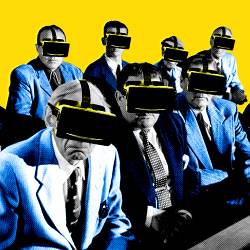
Sifting through piles of evidence in a courtroom trial is a difficult, time-consuming endeavor. It also carries enormous responsibility for judges and juries, who must make critical decisions about defendants and litigants. "There's often a need to recreate or reenact a crime scene. But too much technical information can actually confuse, rather than clarify things," says Robert Stines, a partner in the Tampa, FL, office of Chicago-based law firm of Freeborn & Peters LLP.
Such trials and tribulations are nothing new. However, the maturation of virtual reality (VR) technology could change the courtroom in profound ways. Judges and jurors could don head-mounted displays (HMDs) and view events—everything from automobile collisions to murders—in an ultra-realistic way. VR could serve up different perspectives and angles, as well as reenacting things in varying lighting, sound, and weather conditions.
The concept is not without controversy. Although a few researchers and legal experts have dabbled with the technology in the past, advances in the technology are now making it viable. Questions exist about whether the technology could give one side an unfair advantage. There are also questions about what constitutes an "accurate" depiction of a crime scene and what, if any, standards should exist.
Nevertheless, "It's clear that VR will play a role in courts in the future," Stines says.
Courting VR
The appeal of virtual reality in the courtroom is not difficult to understand. "Such recreations can help to verify or impeach the testimony of witnesses, test forensic theories, and enhance courtroom understanding of a past event," notes Jeremy Bailenson, Thomas More Storke Professor of Communication at Stanford University.
Virtual reality could extend evidence far beyond drawings, animations, and technical facts. It could help to verify or impeach the testimony of witnesses, test forensic theories, and enhance courtroom understanding of a past event.
"Because it is possible to render a 3D (three-dimensional) scene to a third-party observer from any point of view, virtual reality can be used to demonstrate whether a witness actually could have seen the crime," explains Bailenson, founding director of Stanford's Virtual Human Interaction Lab, and author of Experience on Demand: What Virtual Reality Is, How It Works, and What It Can Do.
There are potential practical benefits as well. "Traditional means of documenting, sketching, and photographing crime scenes can be laborious, and they do not provide data outputs suitable for presentation in court to non-experts," wrote Caroline Sturdy Colls, an associate professor of forensics at Staffordshire University in the U.K., in a 2016 blog post.
Colls studied the use of VR in the courtroom under a 2016 European Commission research grant of just over €183,000 (about US$210,000). The Dig-For-Arch project is an ongoing examination of tools and technologies for forensic 3D, 4D, and 5D modeling.
VR technology, Colls noted, has the "potential to…permit access to difficult and/or dangerous environments, create a more accurate record of buried or concealed evidence, and provide more effective means of presenting evidence in court."
Stines says that the technology could allow juries to visit crime scenes without actually traveling to them—thus saving time and money. It could also allow courts to operate virtually. "It could fundamentally change the way society approaches trials," he says.
Virtual Judgement
Like many emerging technologies, the idea of inserting virtual reality into the courtroom raises concerns. "Key questions include: what would be admissible in court, and who would be able to use virtual reality and for what purpose?" Stines says. For example, "If you visit a crime scene virtually, will the prosecution provide one virtual scene and the defense another? What will be considered too gory or realistic? How will judges determine what's prejudicial and what constitutes an unfair advantage, even if a virtual scene is accurate?"
Stephanie Lacambra, a former public defender who is now a staff attorney for the Electronic Frontier Foundation (EFF), believes the technology is too nascent to be used in the courtroom. "There haven't been independent peer reviews, studies, and public policy debates about the costs and benefits of using this kind of technology in the criminal justice system," she argues. "We'd need that to decide what kind of regulations should be put in place, and what minimum requirements there should be for accuracy, transparency, fairness, and accountability."
Bailenson believes VR technology is coming, but he agrees that some thought and consideration must go into defining the boundaries. "Given that VR has the potential to be more influential than most typical animations used in the courtroom, it is essential that the simulations are used when they illustrate a point that necessitates the use of the medium. Courtrooms should be wary of use cases that simply amount to 'bells and whistles,' or gratuitous uses of the technology."
Samuel Greengard is an author and journalist based in West Linn, OR, USA.



Join the Discussion (0)
Become a Member or Sign In to Post a Comment